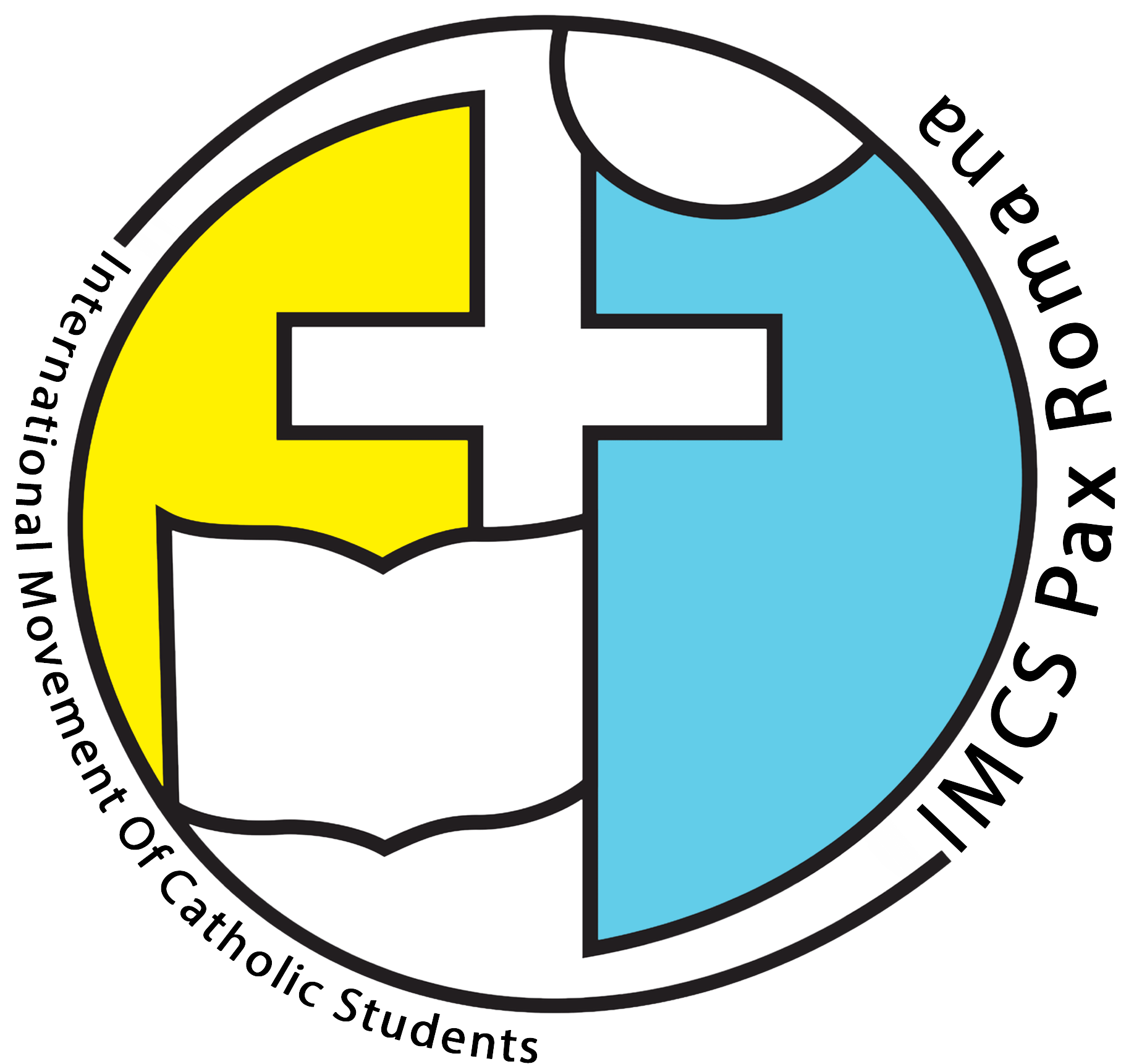A Brief History of IMCS-Pax Romana
1887-1921: Prehistory: The International Union of Catholic Students
“If Catholics were not the first to found an international student union, it seems at least that they were the first to have the idea.” In 1887, Baron George de Montenach of Fribourg, Switzerland, the president of the Swiss Students’ Society proposed the idea at the General Assembly of the Society to create an “International Union of Catholic Students.” On August 23rd, 1887, Montenach’s idea was accepted by the Society and it was approved by Pope Leo XIII. The bishop of the diocese, the future Cardinal Mermillod, led the discussions of the provisional committee. Georges de Montenach was chosen as President of the Union and traveled around Europe to visit with the existing student organizations and to help in the establishing of new ones.
The Union would play an important role as it was closely linked with what was called the Fribourg Union. The Fribourg Union, made up of lay intellectuals met each October from 1885 to 1891 to study contemporary problems that had emerged with the divisions of classes, the emergence of the industrial worker class and the other social problems emerging in the era of industrialization. Because of this work, the Fribourg Union was charged with the task to be a “think-tank” in helping Pope Leo XIII to draft the historic foundational document of modern Catholic Social Teaching, Rerum Novarum by Pope Leo XII.
Because of the efforts of Montenach and other leaders, over 7,000 students traveled to Rome in 1891 for a pilgrimage. As part of that event, 1,700 of them attended the assembly of the Union and 300 of them worked on drafting the statutes, with Fribourg as the headquarters. “Unfortunately, political complication soon gave a mortal blow to this young Union. And eventually very little remained of this Congress. Different efforts, notably in 1893, 1900 and 1917, to give life again to the Union, were fruitless.”
Although the International Union of Catholic Students was short lived its vision would continue with the national groups, especially the Swiss Students’ Society, the Federazione Universitaria Cattolica Italiana (FUCI) and the different German student associations.

1921: Foundation of “Pax Romana” The International Confederation of Catholic Students
In 1920, Georges de Montenach was chosen as the president of the newly created International Catholic Study Union, (forerunner of ICMICA). In this spirit, the Swiss students were again inspired to recreate an international union of their own. This desire was deepened by the urgency for reconciliation in a world recently torn apart by the First World War.
In 1920, the Swiss Students’ Society charged its president and secretary, Max Gressly and Father Tschuor, to deepen the contacts with other students groups, especially those in Holland and Spain. Dr. Gerard Brom, General Secretary of the Netherlands Catholic Associations of Students responded quickly to this effort and a coalition of students from the three neutral countries during the war (Switzerland, Holland and Spain) was created.
At a meeting between Max Gressly and Dr. Brom in early 1921, it was decided to gather together the different associations of students in July. Mr. Gressly sought approval from the Vatican for this effort and on June 5th, 1921 Pietro Cardinal Gasparri conveyed the approval of the Vatican for this effort. With this approval, an organizing committee was set up with student representatives from Switzerland, Spain and Holland.
On July 19th, 1921, these efforts came to fruition when student leaders from twenty-three countries from all over war torn Europe, the United States, Argentina, and Java (Indonesia) met in Fribourg, Switzerland for the first Pax Romana Congress. Peace was a central theme of this meeting as the students wanted to bring reconciliation to a world torn apart by war.
Most of the students at the Congress either fought in the First World War or knew people who had and as a result they were divided at the beginning of the Congress. By the end of the Congress, however, the participants were embracing each other, German, French, Italian, American, Swiss, etc. It was in this spirit that the Congress decided to create an international secretariat under the name “Pax Romana” with the idea that the students could work to build peace in world under the motto of “Pax Christi in Regno Christi.”
At the first Congress, Max Gressly was elected as the first President of Pax Romana with Abbé Johannes Tschuor as Secretary General. In August of 1921, shortly following the first Congress, a study week was held in Ravenna, Italy. At this meeting, Blessed Pier Giorgio Frassati, an active member of the Italian Federation FUCI, raised the awareness of the movement to unemployment and labor issues.
Fribourg was the site of the Second Congress, in August of 1922 where the delegates (which included one from Japan) showed the same desire for solidarity and deepened the vision for this new global movement. They decided to start a work of student hostels and the publication of a bulletin.
In 1925, Pax Romana was defined as “a Catholic Confederation of students from all over the world” with the “aims to include and represent all legitimate forms of Catholic organizations in the university world and to serve as an instrument of coordination for all their varied activities, while leaving to each organization complete freedom to develop its own mystique and methods consisting with it’s own ends.”
During the first twenty years, Abbé Joseph Gremaud of Switzerland would play an important role in supporting the work of the movement as the second president of Pax Romana (1923-1924), the second Secretary General (1925-1946) and later the first International Chaplain of IMCS (1947-1953).

Global Advocacy
From the very beginning, Pax Romana worked closely with other international organizations. Because many of the goals of Pax Romana were similar to that of the League of Nations, Pax Romana was invited to participate in a special way and was able to give input to meetings of the League. In 1927, Pax Romana and the organization of Catholic women, invited the presidents of the major International Catholic (lay) Organizations working at the League together to discuss common issues. At this meeting, the Conference of (Presidents) International Catholic Organizations (ICO) was created.
World War II
As tensions in Europe began to rise, Pax Romana was urged by the Pope to find roots in North America. In 1938, Pax Romana elected its first non-European president, Edward Kirchner of the United States and in September of 1939, Pax Romana held its World Congress at Fordham University in New York and Catholic University in Washington, DC.
As the meeting was underway, Germany invaded Poland, sparking the Second World War. In response to the news, the members of the Congress, which included student from Poland, Germany, France, Italy, China, India, and the United Sates gathered in prayer before the Blessed Sacrament at the National Shrine of the Immaculate Conception in Washington. As a result of the War, the charted ship for the European delegates was cancelled and hundreds of students were stranded in the United States.
After several weeks, many of the students could find ways to return home, but some chose to stay and support the work of the movement throughout the Americas. During the War, Pax Romana opened a temporary office in Washington, DC. There under the leadership Ed Kirchner and with the help of Fr. John Courtney Murry, SJ, the office helped strengthen the federations in the Americas and helped coordinate some war relief efforts. During the War, Rudi Salat (Germany), one of the leaders stranded in the Untied States, after the Congress played an important role in promoting and organizing the movement in Latin America.
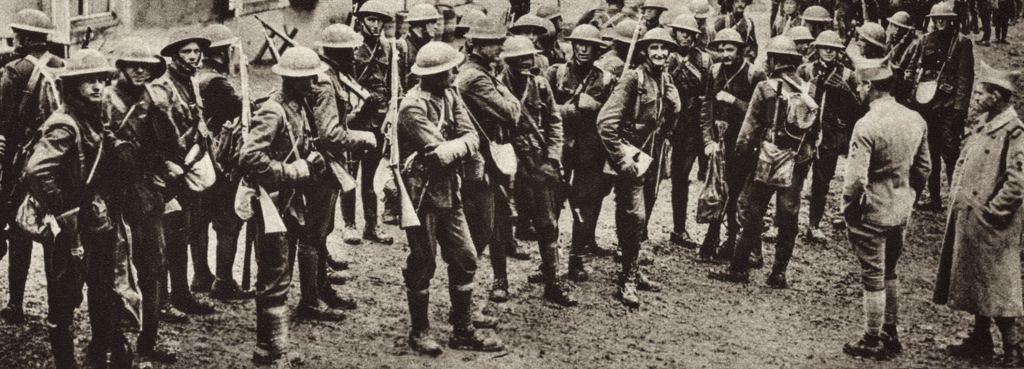
Relief Efforts
During and after the War, Pax Romana continued the important work of relief efforts to students who were negatively affected by the conflict. In this effort, Pax Romana and the World Student Christian Federation created a joint student Entr’aide program, which eventually grew into the World University Service. During the war, both the Washington and Fribourg secretariats would take leadership roles in these efforts.
As part of this program, Pax Romana was asked by the Swiss Catholic Mission to coordinate a book service. By the end of June 1946, 600,000 books in 15,000 parcels and 250 cases had been sent to student prisoners. The Vatican and the US National Catholic Welfare Conference funded these efforts.
Pax Romana also helped create the European Fund for Aid to Students, which became in August 1943 the World Fund for Aid to Students. This fund was run by a committee which had Fr. Gremaud (Pax Romana Secretary General) as Vice-President from the start. André Florinetti, the future President of Pax Romana, also became a member in 1942. This service came to the help of students who were prisoners of war and refugees.
The committee of this fund carried out its work until the end of 1949. After the end of hostilities, the efforts focused on helping students suffering from tuberculosis at Leysin, maintenance of rest centers at Combloux (France), Rocca di Papa (Italy), and Ashton Hayes (Great Britain). The Committee also helped in the opening of university hostels in China and India, and the sending of books, pharmaceutical products and laboratory equipment into these countries.
Post War
After the War, the full time work of the secretariat moved back to Fribourg and Pax Romana again brought together students from warring countries together based in the common identity of being a Catholic student. In this post war period, Pax Romana focused on:
- strengthening and developing new national Catholic student federations, in Latin America, Africa and Asia,
- setting up a series of important services for students (including scholarship funds for African and Asian students to attend universities in Europe),
- helping in the resettling and relief efforts of refuges after the War,
- organizing students together in “specialized secretariats” based in their fields of study (Medicine (1932), Press (1932), Law (1934), Comparative Literature (1935), etc) and
- setting up a series of important services for students (including scholarship funds for African and Asian students to attend universities in Europe)
Many of these efforts would result in the foundation of autonomous organizations and services.
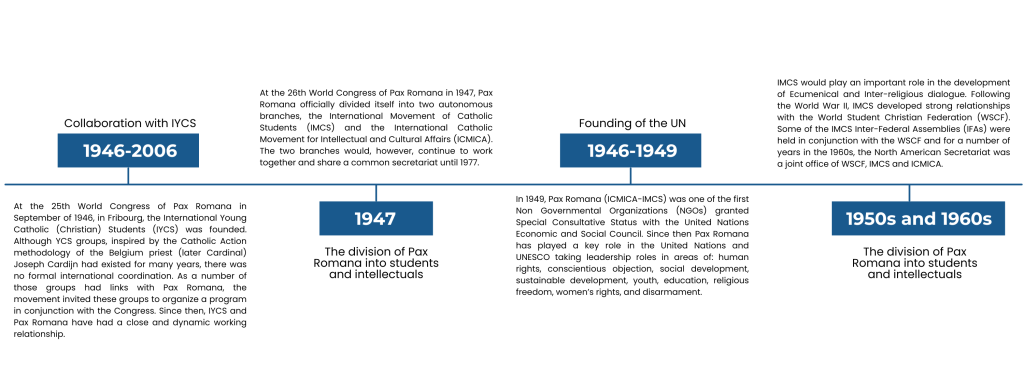
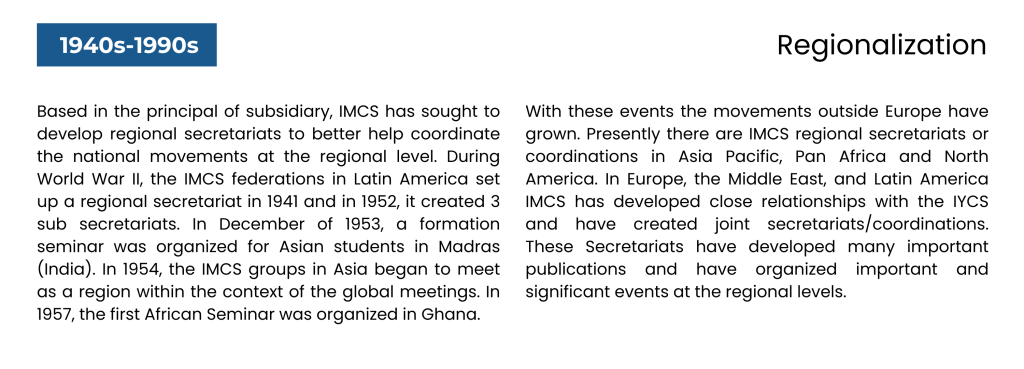
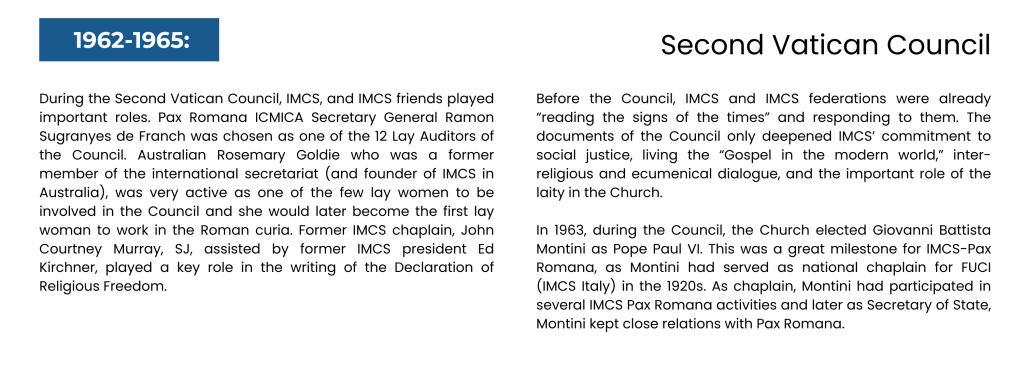
1968: Student Revolution
European and American IMCS federations were greatly impacted by the May 1968 Revolution at the University of Pars and the anti-Vietnam War movements. Many students were empowered by these events, but sadly some of the national movements experienced a sharp decline.
1970s
In the 1960s and 1970s, IMCS, inspired by the Vatican Council, regional bishops meetings, the major social encyclicals and the experiences of its members, focused its attention on the poor and the marginalized.
At this time, IMCS in Latin America was growing closer to IYCS. A number of IMCS federations were in fact YCS groups in the university and were double affiliated to both. In Latin America, the two movements worked very closely and took leading roles in Liberation Theology. Former IMCS member and Chaplain of IMCS Peru (UNEC), Fr. Gustavo Gutierrez, OP would have a significant impact on IMCS, the Church, and the world (especially Latin America) with the writing of “A Theology of Liberation” (1971). This foundational text of Liberation Theology references IMCS, IMCS national movements and members several times.
A significant moment in IMCS occurred in the 1971 IFA in Fribourg. While celebrating IMCS’ 50th anniversary, this 27th IFA focused on “Liberation – How?” This IFA changed the methods in which IMCS held international meetings. Instead of hearing from eminent personalities and then having student workshops, the 1971 IFA began with the student experience and held study sessions in methods drawing from the Catholic Action methods.
The next IMCS IFA would take place in Lima in August of 1975 with 80 delegates coming from 32 national federations. This IFA used the same methodology as in 1971 and focused on the theme “Christian Commitment in a world in crisis.” This meeting reexamined the role and life of IMCS and committed itself to the preferential option for the poor.
 IMCS would also impact Liberation Theology in the Asian context with Tissa Balasuriya, O.M.I of Sri Lanka serving as an active chaplain to IMCS at the local and regional level.
IMCS would also impact Liberation Theology in the Asian context with Tissa Balasuriya, O.M.I of Sri Lanka serving as an active chaplain to IMCS at the local and regional level.
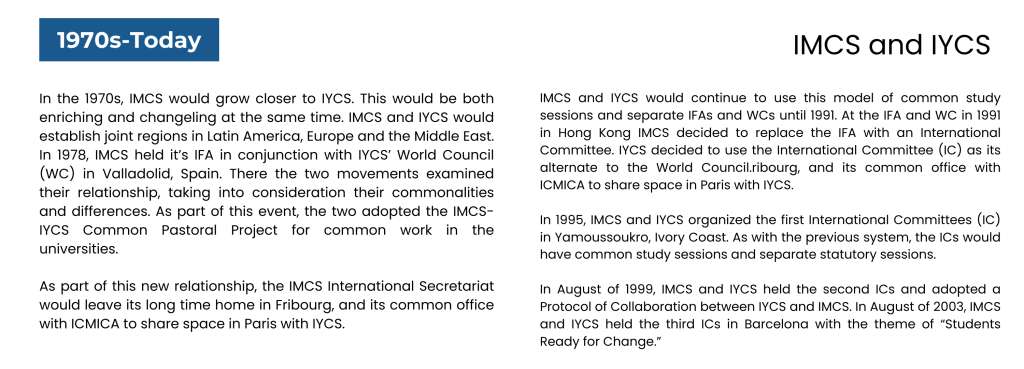
Other Important Moments
There are other very important moments in the history of IMCS that are not detailed here, including the publications of IMCS, the role of IMCS in the Vatican (including the World Youth Days), and the work of IMCS at the United Nations.
Share This:

IMCS Asia Pacific
The International Movement of Catholic Students (IMCS) Asia Pacific is a dynamic regional organization dedicated to empowering young Catholics to actively engage in social justice, human rights, and sustainable development. Through education, advocacy, and collaboration, IMCS aims to nurture leadership, build solidarity, and inspire students to be agents of change within their communities and beyond.
@2020 - IMCS AP - All Rights Reserved.
